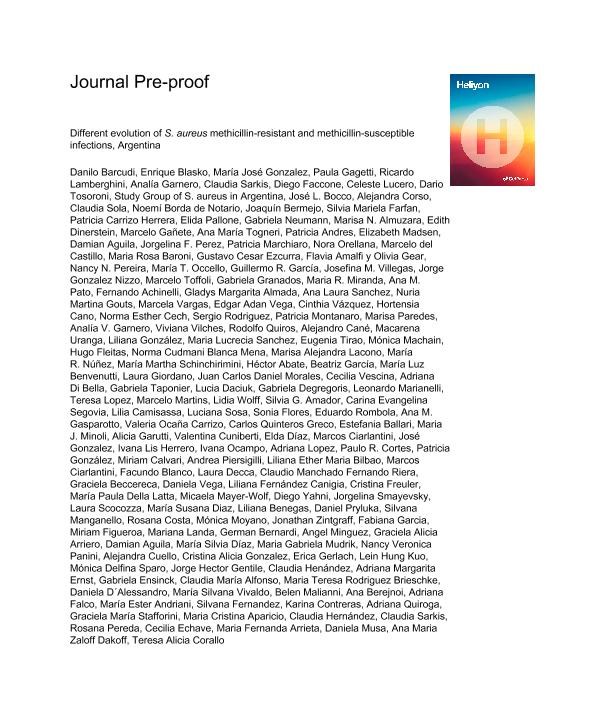Artículo
Different evolution of S. aureus methicillin-resistant and methicillin-susceptible infections, Argentina
Barcudi, Danilo Andres ; Blasko, Enrique Gabriel; Gonzalez, María José; Gagetti, Paula Silvana; Lamberghini, Ricardo; Garnero, Analía; Sarkis, Claudia; Faccone, Diego Francisco
; Blasko, Enrique Gabriel; Gonzalez, María José; Gagetti, Paula Silvana; Lamberghini, Ricardo; Garnero, Analía; Sarkis, Claudia; Faccone, Diego Francisco ; Lucero, Celeste; Tosoroni, Dario; Bocco, Jose Luis
; Lucero, Celeste; Tosoroni, Dario; Bocco, Jose Luis ; Corso, Alejandra; Sola, Claudia del Valle
; Corso, Alejandra; Sola, Claudia del Valle
 ; Blasko, Enrique Gabriel; Gonzalez, María José; Gagetti, Paula Silvana; Lamberghini, Ricardo; Garnero, Analía; Sarkis, Claudia; Faccone, Diego Francisco
; Blasko, Enrique Gabriel; Gonzalez, María José; Gagetti, Paula Silvana; Lamberghini, Ricardo; Garnero, Analía; Sarkis, Claudia; Faccone, Diego Francisco ; Lucero, Celeste; Tosoroni, Dario; Bocco, Jose Luis
; Lucero, Celeste; Tosoroni, Dario; Bocco, Jose Luis ; Corso, Alejandra; Sola, Claudia del Valle
; Corso, Alejandra; Sola, Claudia del Valle
Fecha de publicación:
11/2023
Editorial:
Elsevier
Revista:
Heliyon
ISSN:
2405-8440
Idioma:
Inglés
Tipo de recurso:
Artículo publicado
Clasificación temática:
Resumen
Staphylococcus aureus-(SA) is widespread among healthcare-associated-(HA) and the community-associated-(CA) infections. However, the contributions of MRSA and MSSA to the SA overall burden remain unclear. In a nationally-representative-survey conducted in Argentina, 668 SA clinical isolates from 60 hospitals were examined in a prospective, cross-sectional, multicenter study in April 2015. The study aimed to analyze MRSA molecular epidemiology, estimate overall SA infection incidence (MSSA, MRSA, and genotypes) in community-onset (CO: HACO, Healthcare Associated-CO and CACO, Community-Associated-CO) and healthcare-onset (HO: HAHO, Healthcare-associated-HO) infections, stratified by age groups. Additionally temporal evolution was estimated by comparing this study´s (2015) incidence values with a previous study (2009) in the same region. Erythromycin-resistant-MSSA and all MRSA strains were genetically typed. The SA total-infections (TI) overall-incidence was 49.1/100,000 monthly-visits, 25.1 and 24.0 for MRSA and MSSA respectively (P=0.5889), in April 2015. In adults with invasive infections (INVI), MSSA was 15.7 and MRSA was 11.8 (P=0.0288), 1.3-fold higher. HA SA infections, both MSSA and MRSA, surpassed CA infections by over threefold. During 2009-2015, there was a significant 23.4% increase in the SA infections overall incidence, mainly driven by MSSA, notably a 54.2% increase in INVI among adults, while MRSA infection rates remained stable. The MSSA rise was accompanied by increased antimicrobial resistance, particularly to erythromycin, linked to MSSA-CC398-t1451-ermT + - IEC+ -pvl- emergence. The SA-infections rise was primarily attributed to community-onset infections (37.3% and 62.4% increase for TI and INVI, respectively), particularly HACO MSSA and HACO-MRSA in adults, as well as CACO-MSSA. The main CA-MRSA-PFGEtypeN-ST30-SCCmecIVc-PVL+/- clone along with other clones (USA300-ST8-IV-LV-PVL+/- , Journal Pre-proof 5 PFGE-typeDD-ST97-IV- PVL- ) added to rather than replaced CA-MRSA-PFGE-typeI-ST5- SCCmecIVa-PVL+/- clone in HA invasive-infections. They also displaced clone HA-MRSA PFGE-typeA-ST5-SCCmecI, mainly in HAHO infections The overall-burden of SA infections is rising in Argentina, driven primarily by community onset MSSA, particularly in adults, linked to increased erythromycin-resistance and MSSACC398-t1451-ermT + -IEC+ -pvl- emergence. Novel knowledge and transmission-control strategies are required for MSSA
Palabras clave:
STAPHYLOCOCCUS AUREUS
,
MRSA
,
METHICILLIN-RESISTANCE
,
EVOLUTION
Archivos asociados
Licencia
Identificadores
Colecciones
Articulos(CIBICI)
Articulos de CENTRO DE INV.EN BIOQUI.CLINICA E INMUNOLOGIA
Articulos de CENTRO DE INV.EN BIOQUI.CLINICA E INMUNOLOGIA
Articulos(SEDE CENTRAL)
Articulos de SEDE CENTRAL
Articulos de SEDE CENTRAL
Citación
Barcudi, Danilo Andres; Blasko, Enrique Gabriel; Gonzalez, María José; Gagetti, Paula Silvana; Lamberghini, Ricardo; et al.; Different evolution of S. aureus methicillin-resistant and methicillin-susceptible infections, Argentina; Elsevier; Heliyon; 11-2023; 1-53
Compartir
Altmétricas



